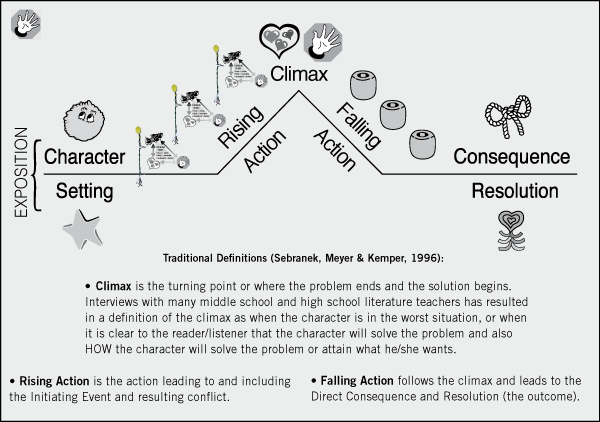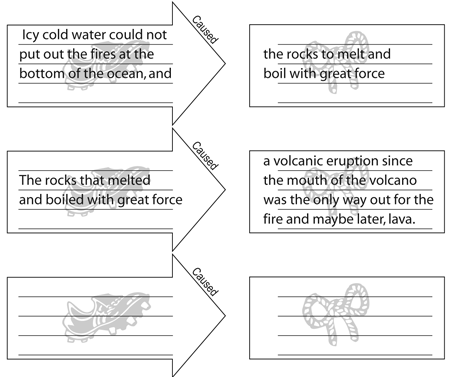Secure Checkout + FREE SHIPPING (U.S. Orders over $60)
Menu
-
- Home
-
About Us
-
The Approach
-
Linking Language & Literacy
-
Professional Learning
-
Learning Resources
-
SHOP
-
Blog
-
- About MindWing
- Our People
- Contact Us
- Your Account
- Login
-
United States (USD $)

Secure Checkout + FREE SHIPPING (U.S. Orders over $60)
Understanding Novels / Chapter Books with SGM — Part 4
by Maryellen Rooney Moreau February 03, 2016 2 min read
To date in this gradual analysis of The Big Wave, we have talked about the characters within a geographic setting, one where the physical happenings inherent in a setting such as Japan may involve volcanic eruptions, earthquakes and tsunamis. This setting also takes into consideration the cultures of those living in the setting. You may elaborate upon these aspects as you wish to build knowledge of the land and its people.
When students approach fifth grade, a graphic known as the “Plot Diagram” or the “Plot Mountain” is shown as a way to organize the plot of a story, a chapter, or the events in a novel such as The Big Wave. Below is our version from The ThemeMaker Teacher’s Manual.

We have taken this diagram and modified it slightly, adding SGM® icons on top of it to show the relationship between the SGM® and the Plot Diagram. Although classroom teachers in middle schools may not necessarily use the SGM®, the thinking process is the same.

Today we begin with the two major episodes of the story. These drive the plot and are considered the “Rising Action.” Notice the Story Grammar Marker symbols along this rising line. To the right of these three SGMs, there are Critical Thinking Triangles. These are fabulous tools to use to quickly analyze a characters’ motivation through what he/she does, says, thinks and feels.
The book up until now describes life on this island.
Pages 10–12 describe through conversation, the philosophy of the Japanese. These conversations foreshadow the dangers of the sea a volcanic island setting. Foreshadowing is a form of figurative language authors use to “set-up” a plot.
Pages 13–15 shows a carefree view of everyday (ho-hum) life where the boys, Kino and Jiya, enjoy each others’ company and realize that both fishing and farming are necessary to life. On page 15 there is an opportunity to use a ThemeMaker Expository Sequence Map to sequence the steps of a volcanic eruption caused by fires on the bottom of the sea. It is important for students to know that exemplary authors, such as Pearl S. Buck, weave their own knowledge and acquired information throughout their novels.

This expository scenario could also be mapped as Cause/Effect (map shown below is a partial from ThemeMaker), by relating the sequence of steps to each other in a causal way:

![]() (Kick-Off) Icy cold water could not put out the fires at the bottom of the ocean, so the rocks melted and boiled with great force.
(Kick-Off) Icy cold water could not put out the fires at the bottom of the ocean, so the rocks melted and boiled with great force.
![]() (Kick-Off) If the rocks are melted and boiled with great force →→→ it causes a volcanic eruption since the mouth of the volcano was the only way out for the fire and maybe later, lava.
(Kick-Off) If the rocks are melted and boiled with great force →→→ it causes a volcanic eruption since the mouth of the volcano was the only way out for the fire and maybe later, lava.
Other Blogs in This Series:
Maryellen Rooney Moreau
Maryellen Rooney Moreau, M.Ed., CCC-SLP, is the founder of MindWing Concepts. She earned her Bachelor of Arts degree in Communication Disorders at University of Massachusetts at Amherst as a Commonwealth Honors Scholar, and a Masters of Education in Communication Disorders at Pennsylvania State University. Her forty-year professional career includes school-based SLP, college professor, diagnostician, and Coordinator of Intervention Curriculum and Professional Development for children with language learning disabilities. She designed the Story Grammar Marker® and has been awarded two United States Patents. She has written more than 15 publications and developed more than 60 hands-on tools based on the SGM® methodology. Maryellen was awarded the 2014 Alice H. Garside Lifetime Achievement Award from the International Dyslexia Association, Massachusetts Branch.
Leave a comment.
Comments will be approved before showing up.
